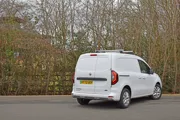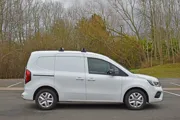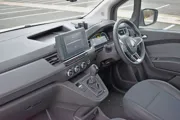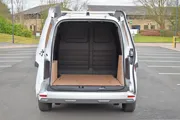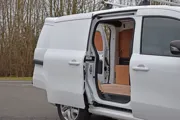Review
Infotainment and technology
Van technology has come on leaps and bounds in the last few years as manufacturers cram in more safety and infotainment features to make their commercial vehicles more akin to passenger cars.
Our Kangoo is a great example of this evolution. It comes packed with driver aids and features that would have once been reserved for top-end premium cars.
But the move to more tech-friendly vans isn’t just about safety and driver comfort, it’s also crucial for the effective deployment of electric vehicles.
Connected vehicle technology is one of the features our Kangoo has. It means the van has a constant wireless internet connection, using a built in SIM card, that enables it to be managed remotely.
Renault offers its own fleet management platform with integrated telematics, allowing fleet managers to track vehicles, monitor driver behaviour and receive vehicle health alerts.
For drivers, there’s the My Renault smartphone app. It allows you to interact with the van remotely, at any time. You can check the range, see the vehicle’s current location, send a destination to the sat-nav and pre-heat or cool the cabin. The app will also notify you if the vehicle is unlocked or if there is a technical fault.
We recently left the Kangoo changing at a public charge point, which failed after about five minutes. Using the app we were able to return to the van and sort out the issue, otherwise we could’ve wasted an hour thinking it was charging when it wasn’t.
The app also includes a route planner that will factor in charging stops along the way.
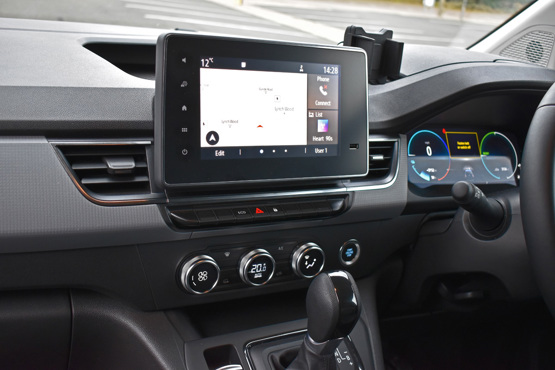
Away from the ‘connected’ features, the Kangoo’s built-in touchscreen also offers wireless smartphone connectivity via Apple Carplay and Android Auto.
The system itself is very simple and easy to use. It’s derived from Renault’s passenger car range. There’s Bluetooth, DAB radio and sat-nav. You can also alter some basic vehicle settings from the touchscreen. Our only criticism is the graphics are little dated and the system can feel a bit slow when compared to the newest ones on the market.
Our Kangoo also benefits from a suite of driver aids, included in the £1,500 Advanced Driver Assist Pack. There’s adaptive cruise control and lane keeping assist, which provides semi-autonomous driving capability on motorways and major roads. We also have blind-spot monitoring and traffic sign recognition.
Two rear-view cameras are fitted. The first provides a typical reversing camera function via the infotainment screen and comes in the Parking Assist Pack (£570), along with front and rear parking sensors.
The other camera is used for a digital rear-view mirror via a second display mounted at the top of the windscreen. The always-on rear-view display is a great feature that not many vans offer, albeit a costly option at £960. It gives the driver much greater rearward visibility from the cab.

Loadspace and payload
Adapting to daily life with the Renault Kangoo hasn’t been too tricky. It’s packed with creature comforts, such as air con, sat-nav and adaptive cruise control. It’s also easy to drive, with good visibility and a compact footprint.
There’s clearly lots of ‘car DNA’ in the Kangoo – it’s underpinnings can be traced to the Nissan Qashqai. But a great driving van is one thing, a practical business tool can be quite the other.
The Kangoo line-up is split across ‘medium’ and ‘long’ wheelbase versions, with panel van and crew cab configurations. The most spacious Kangoo has 4.3 cubic metres of loadspace and a payload of up to 987Kg.
Our Kangoo E-Tech is the smaller of the two wheelbases. It offers a 3.3-cubic metre loadspace, behind its fixed bulkhead.
The load bay measures 1,810mm in length and has a height of 1,215mm. The maximum width is 1,570mm, shirinking to 1,248mm between the wheel arches.
Opting for the electric powertrain means there’s a payload penalty of almost 150Kg when compared to an equivalent diesel Kangoo. The payload for our model is therefore 608Kg.
It’s not class-leading, then. The Stellantis small van platform – used for the Citroen Berlingo, Peugeot Partner and Vauxhall Combo – can carry up to 800Kg, with the same loadspace volume.
The longer wheelbase Kangoo has a greater payload capacity of 764Kg.

Working in the Kangoo’s favour is the pair of standard-fit sliding side doors, allowing the van to be loaded and unloaded from either side. We’ve found this particularly useful at the end of the day when the van needs to be plugged in. You can exit the driver’s door and immediately slide open the side door to get the cables out, rather than having to walk around to the rear, or the other side.
On the subject of charging cables. One gripe we do have is that there’s no where practical to store them. It may not be an issue for everyone, but if you do have to carry around the two devices – one for 230v domestic sockets and the other for standard wallboxes – they do take up room in the back.
Another feature that has made life with the Kangoo so easy is the handsfree keyless entry system. Instead of a regular key, the Kangoo comes with slim plastic fob. It unlocks the vehicle on approach, so you can just pull a door handle to gain access. When you’re ready to drive, hit the start button and it’s good to go. They fob can stay in you pocket the entire time.
To lock the van, simply walk away. There’s an audible chirp so you can be sure the vehicle is secure.
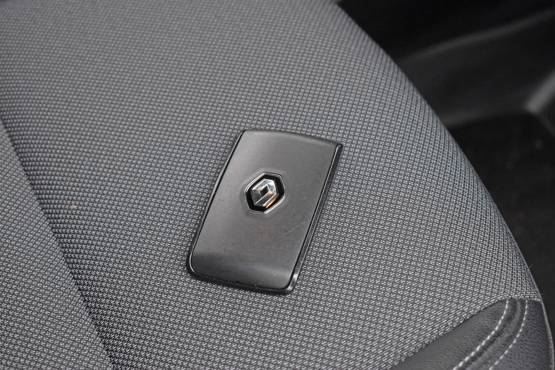
Renault Kangoo E-Tech Advance MWB joins our test fleet
Our latest long term test vehicle is the all-new Renault Kangoo, it’s the fully-electric E-Tech model in Advance trim. Including options our van comes in at £40,531.
The Kangoo is available in a choice of two wheelbases - 2.7 and 3.2 metres – offering maximum load volumes of up to 3.3 and 4.2 cubic metres, respectively. We've opted for the shorter of the two models.
All vans come with automatic headlights and wipers, 3.5-inch driver display, DAB radio with Bluetooth and USB connectivity, heated mirrors, and a height-adjustable driver’s seat. Also standard is a selection of safety features, such as hill start assist, emergency E-call, and cruise control with speed limiter.
In addition, our Advance model includes an eight-inch touchscreen with Android Auto and Apple CarPlay, an electric hand brake, reverse parking sensors, passenger bench seat, cloth upholstery with yellow accents, 16-inch alloy wheels, body-coloured door rails and has a set of options fitted including Advanced Lane Keep Assist and Adaptive Cruise Control and a rear parking camera.
Our van is also fitted with a digital rear view mirror due to the van’s full height bulkhead and while this offers decent rear visibility it’s very difficult to judge distance due to the cameras wide angle.

The passenger bench seat makes the van a three-seater and has a central folding backrest that turns into a work surface. Inside the cab there’s almost 44 litres of storage from the various compartments.
In the back we have plywood protection for the floors, side panels and wheel arches the also the option of having the ‘Easy Inside Rack’ which is located in the ceiling which makes it possible to transport objects nearly 2.5 metres long inside the van which leaves the floorspace free for other items.
All models of the Kangoo E-Tech electric are advertised with up to 186 miles (WLTP) of driving range thanks to its 45 kWh battery, however we have found this to be lacking, as winter descends, the van is indicating around 100 miles range fully charged and is currently being driven unloaded which is disappointing.
On the charging front, Renault says that a 7.4kW charging point can recharge the battery from 20% to 80% in just over four hours, a 22 kW charger can achieve an 80% charge in 1 hour 21 minutes and an 80kW fast DC charger can achieve a 20% to 80% charge in just 40 minutes. The battery is covered by an eight-year or 100,000 miles warranty.
Using the My Renault app, you can do useful things such as preheat or cool the cabin or remotely start or schedule charging to begin to take advantage of off-peak times.
Over the coming months we'll be putting the Kangoo through its paces, to see how easy is it to live with and what the real-world range is.





